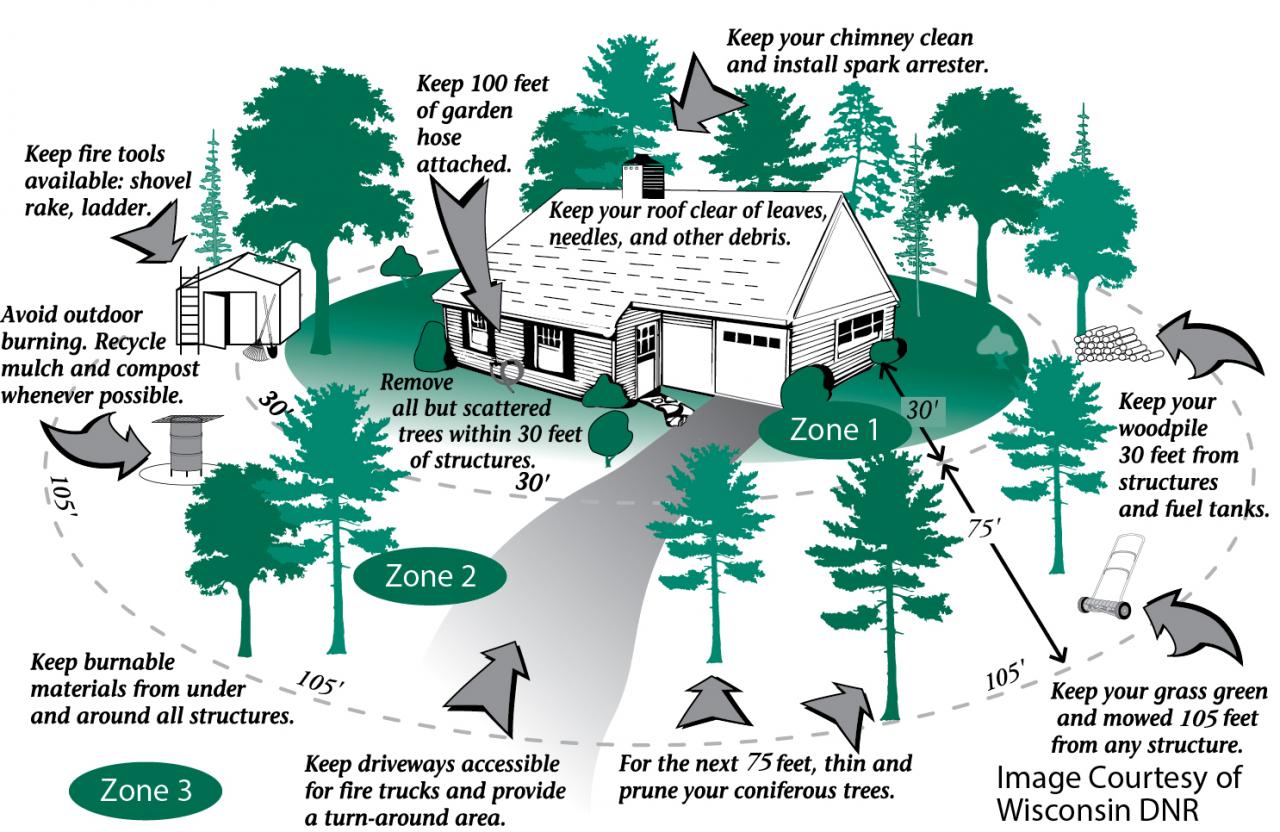Note: This is a recently revised (April 2022) publication from K-State Research and Extension, MF-2241 https://www.bookstore.ksre.ksu.edu/pubs/MF2241.pdf
Wildfires have always been part of the Kansas landscape. As the rural population increases, so does the need to protect life and property from wildfire. While rural fire departments provide this protection to life and property, recent years have increasingly seen fires that exceed the ability of even the best fire departments to control, quickly creating a situation where firefighters simply cannot defend every threatened structure. Additionally, these fires are threatening properties within cities as well, so it is no longer solely a rural concern.
These steps referred to as creating “defensible space” begin inside your home and move out from there.
Defensible Space Zones. (Refer to Figure 1 below)
Zone 1 – Extends 30 feet from the edge of the home or any attached structure such as a deck or patio. This zone requires the most maintenance and the least amount of flammable material.
Zone 2 – Extends 75 feet beyond the edge of Zone 1. This zone contains more vegetation and flammable materials, but still needs regular maintenance activities to reduce fuel load and risk.
Zone 3 – Extends from the edge of Zone 2 to the property boundary. This zone includes the natural surroundings of your home. The vegetation closest to your home in this zone should still receive an annual “clean-up” such as mowing, pruning, removing dead vegetation, and thinning overcrowded trees and shrubs.
Note: Fire moves faster and burns more intensely uphill. Defensible space zones that are downslope from your home need to be extended beyond the recommended distances based on slope steepness.

Figure 1. Defensible space zones
Additional Defensible Space Practices
• Fire-resistant roofing materials such as metal, tile, or at least Class C shingles prevent your roof from being a source of ignition from the hot embers of a wildfire.
• Windows should be at least double paned. In case of wildfire move flammable materials such as curtains and furniture away from windows. Radiant heat can ignite these materials through windows.
• Stone, brick, or other nonflammable siding is safer than wood or vinyl siding.
• Zone 2 should have tree crowns spaced at least 10 feet from each other. All trees in Zones 1 and 2 should be pruned to a height of three times the height of surrounding vegetation (usually 6 to 10 feet), but do not remove more than one third of the live crown.
• Propane tanks, gasoline, and wood piles should be stored 30 feet from structures.
• All exterior vents should be covered with a nonflammable wire mesh 1/8 inch or smaller.
• Remove all dead vegetation from Zones 1 and 2. Especially prune any dead branches that overhang the roof or are within 15 feet of the chimney.
• If your property has no large year-round water source, consider working with neighbors or a home owners association to install one.
• Keep trees pruned and healthy in Zones 1 and 2.
• Maintain power line clearance. Have an arborist assist with existing trees that interfere with power lines. When planting new trees near power lines choose a species that has a mature height less than 25 feet.
• Make sure your address is clearly visible from the road from both directions, especially in low-visibility conditions.
• If you burn trash or use fire for vegetation management, consult local regulations and obtain proper training. Strictly follow all safety precautions.
• Develop a home emergency preparedness plan that includes: clearly posted emergency phone numbers, designated escape routes and meeting places, maintained fire extinguishers, and functioning smoke alarms.
• Teach children fire safety. Remember, children learn best by example!
Recommended Publications
• Ready, Set, Go Kansas Action Guide
• Prescribed Burning: Safety, L565
• Prescribed Burning: Planning and Conducting, L664
Other Information Sources
Your local fire department
Online
This publication is made available in cooperation with the USDA Forest Service. The USDA is an equal opportunity provider, employer, and lender.
Also see another recently revised publication, Red Flag Warning and Fire Weather Information. MF2775.
Eric Ward, Kansas Forest Service